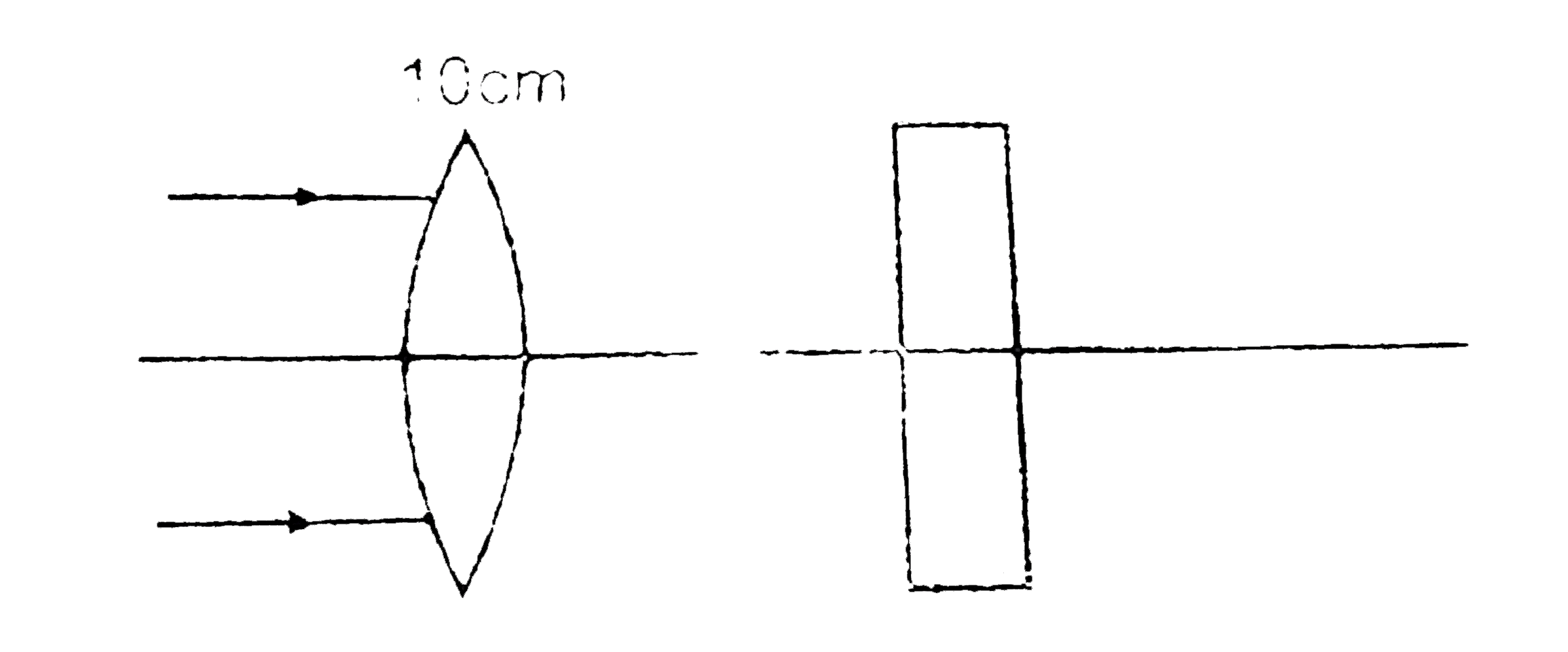(a) Determine the 'effective focal length' of the combination of the two lenses in Exercise 9.10, if they are placed 8.0cm apart with their principal axes coincident. Does the answer depend on which side of the combination a beam of parallel light is incident? Is the notion of effective focal length of this system useful at all?
(b) An object 1.5 cm in size is placed on the side of the convex lens in the arrangement (a) above. The distance between the object and the convex lens is 40 cm. Determine the magnification produced by the two-lens system, and the size of the image.
(a) (i) Let a parallel beam be the incident from the left on the convex lens first
f1=30cmandu1=−∞. , give v1=+30cm. This image becomes a virtual object for the second lens.
f2=−20cm,u2=+(30−8)cm=+22cm which gives, v2=−220cm. The parallel incident beam appears to diverge from a point 216 cm from the centre of the two-lens system.
(ii) Let the parallel beam be incident from the left on the concave lens first:f1=−20cm,u1=−∞, give v1=−20cm. This image becomes a real object for the second lens: f2=+30cm,u2=−(20+8)cm=−28cm which gives, v2=−420cm. The parallel incident beam appears to diverge from a point 416 cm on the left of the centre of the two-lens system.
Clearly, the answer depends on which side of the lens system the parallel beam is incident. Further we do not have a simple lens equation true for all u (and v) in terms of a definite constant of the system (the constant being determined by f1 and f2 , and the separation between the lenses). The notion of effective focal length, therefore, does not seem to be meaningful for this system.
(b) u1=−40cm,f1=30cm, gives v1=120cm.
Magnitude of magnification due to the first (convex) lens is 3.
u2=+(120–8)cm=+112cm (object virtual), f2=−20cm which gives v2=−112×2092cm
Magnitude of magnification due to the second (concave) lens =20/92.
Net magnitude of magnification =0.652
Size of the image = 0.98 cm
Similar Questions
a) Determine the effective focal length of the combination of the two lenses in Exercise, if they are placed 8.0cm apart with their principal axes coincident. Does the answer depend on which side of the combination a beam of paralel light is incident? Is the notions of effective focal length of this system useful at all?
b) An object 1.5 cm in size is placed on the side of the convex lens in the arrangement a) above. The distance between the object and the convex lens is 40cm. Determine the magnification produced by the two-lens system, and the size of the image.
View Solutiona) Determine the effective focal length of the combination of the two lenses in Exercise, if they are placed 8.0cm apart with their principal axes coincident. Does the answer depend on which side of the combination a beam of paralel light is incident? Is the notions of effective focal length of this system useful at all?
b) An object 1.5 cm in size is placed on the side of the convex lens in the arrangement a) above. The distance between the object and the convex lens is 40cm. Determine the magnification produced by the two-lens system, and the size of the image.
View Solutiona) Determine the effective focal length of the combination of the two lenses in Exercise, if they are placed 8.0cm apart with their principal axes coincident. Does the answer depend on which side of the combination a beam of paralel light is incident? Is the notions of effective focal length of this system useful at all?
b) An object 1.5 cm in size is placed on the side of the convex lens in the arrangement a) above. The distance between the object and the convex lens is 40cm. Determine the magnification produced by the two-lens system, and the size of the image.
View SolutionA parallel beam of light is incident on a lens of focal length 10 cm. A parallel slab of refractive index 1.5 and thickness 3 cm is placed on the other side of the lens. Find the distance of the final image from the lens.
 .
.
View SolutionA parallel beam of light is incident on a lens of focal length 10 cm. A parallel slab of refractive index 1.5 and thickness 3 cm is placed on the other side of the lens. Find the distance of the final image from the lens.
 .
.
View SolutionA converging lens of focal length 12 cm and a diverging mirror of focal length 7.5 cm are placed 5.0 cm apart with their principal axes coinciding. Where should an object be placed so that its image falls on itself ?
View SolutionA converging lens of focal length 12 cm and a diverging mirror of focal length 7.5 cm are placed 5.0 cm apart with their principal axes coinciding. Where should an object be placed so that its image falls on itself ?
View SolutionA diverging lens of focal length 20 cm and a converging lens of focal length 30 cm are placed 15 cm apart with their principal axes coinciding. Where should an object be placed on the principal axis so that its image formed at infinity ?
View SolutionA diverging lens of focal length 20 cm and a converging lens of focal length 30 cm are placed 15 cm apart with their principal axes coinciding. Where should an object be placed on the principal axis so that its image formed at infinity ?
View SolutionA convex lens of focal length 20 cm and a concave lens of focal length 10 cm are placed 10 cm apart with their principal axes coinciding. A beam of light travelling parallel to the principal axis and having a beam diameter 5.0 mm, is incident on the combination. Show that the emergent beam is parallel to the incident one. Find the beam diameter of the emergent beam.
View Solution
